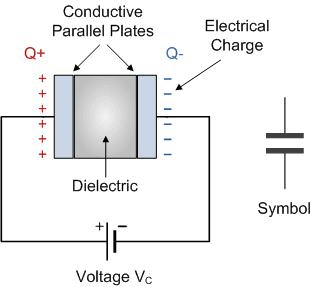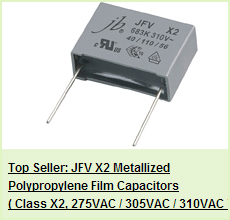jb Introduction to Capacitors
Just like the Resistor, the Capacitor, sometimes referred to as a Condenser, is a passive device, and one which stores its energy in the form of an electrostatic field producing a potential difference (Static Voltage) across its plates. In its basic form a capacitor consists of two or more parallel conductive (metal) plates that do not touch or are connected but are electrically separated either by air or by some form of insulating material such as paper, mica or ceramic called the Dielectric. The conductive plates of a capacitor can be either square, circular or rectangular, or be of a cylindrical or spherical shape with the shape and construction of a parallel plate capacitor depending on its application and voltage rating.
When used in a direct-current or DC circuit, a capacitor blocks the flow of current through it, but when it is connected to an alternating-current or AC circuit, the current appears to pass straight through it with little or no resistance. If a DC voltage is applied to the capacitors conductive plates, a current flows charging up the plates with electrons giving one plate a positive charge and the other plate an equal and opposite negative charge. This flow of electrons to the plates is known as the Charging Current and continues to flow until the voltage across both plates (and hence the capacitor) is equal to the applied voltage Vc. At this point the capacitor is said to be fully charged with electrons with the strength of this charging current at its maximum when the plates are fully discharged and slowly reduces in value to zero as the plates charge up to a potential difference equal to the applied supply voltage and this is show below.







0 Comment so far
Leave a reply